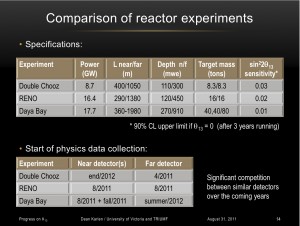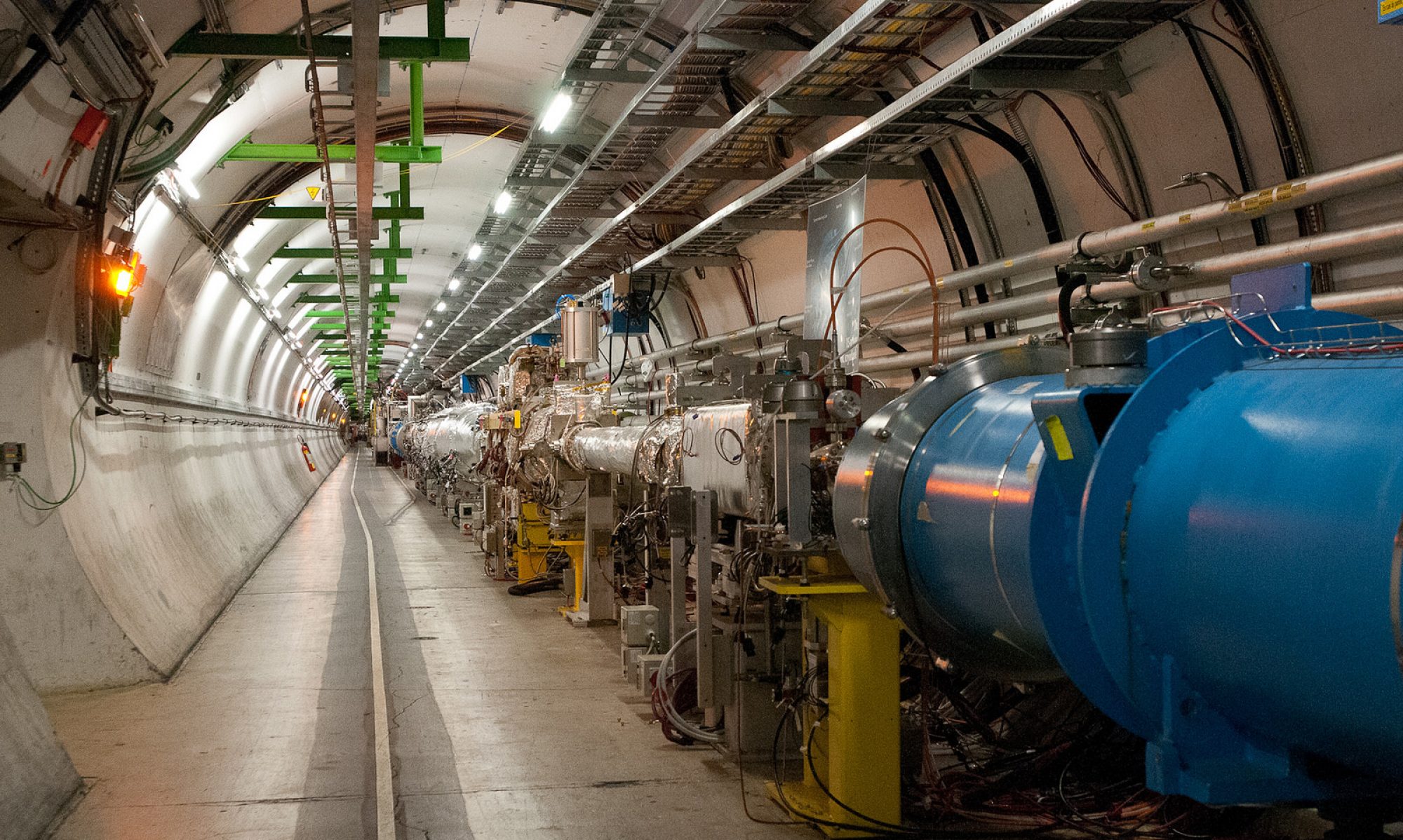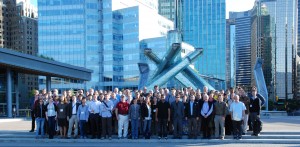
This is a brief report of what I learned from Physics in Collision 2011, held in Vancouver, British Columbia, Canada from August 28-September 1. I cannot cover everything here; I mention topics of interest to me and a few that are of general interest.
The Search for the Standard Model Higgs Boson
The Higgs Boson is the physical state that remains after breaking the electroweak symmetry in the Standard Model. This act of symmetry breaking is the key mechanism for introducing mass into the Standard Model. The Higgs, therefore, is a central prediction of the SM which has yet to be verified. Finding the Higgs is a key goal of particle collider programs at Fermilab (the Tevatron and the experiments CDF and D0) and CERN (the Large Hadron Collider and the experiments ATLAS and CMS).
The was no new information released at PIC2011, so what we know we learned in Mumbai at Lepton-Photon 2011 a couple of weeks ago. The Tevatron and LHC experiments have seen no convincing evidence of the existence of the Standard Model Higgs Boson, though people use words like “hints” to refer to regions of Higgs masses where the data measurement doesn’t agree perfectly with the “null hypothesis” – a treatment of the data where the analysts assume there is no Higgs at all. The Tevatron and LHC have delivered very large data sets which allow the experiments to reach or come close to the production rates predicted by the Standard Model. For the Tevatron, the results are based on samples up to about 3/4 the total expected data sample (~12/fb to be delivered by the Tevatron by its shutoff in October). For the LHC, the results are based on 1-2/fb, representing most of the data collected this year but only about ~1/3 the data expected by summer 2012.
The plots below were taken from talks by Jocobo Konigsberg (University of Florida, on behalf of CDF and D0 Collaborations) and Paolo Meridiani (INFN Rome, on behalf of the ATLAS and CMS Collaborations). They show in yellow the 95% upper limit on the production rate of Higgs bosons in the data sets. All experiments are punching through the SM predicted rate in wide ranges of Higgs mass, and based on the current data from all experiments it seems that most of the masses above about 140 GeV and below 115 GeV are excluded at 95% confidence level. There are regions in the high mass which are not excluded, but what seems clear is that all experiments are going to have sensitivity to these uncovered patched in the next year. That statement seems to also go for the region between 115-140 GeV, which is quickly turning into the most eagerly watched mass range for results since this seems to be the region where the “hints” I mentioned above are residing.
[nggallery id=1]
The Top Quark
Discovered in 1994 at the Tevatron, the Top Quark is rapidly become the new tool of the LHC. Its production rate, both in pairs and as single quarks (thus probing strong production mechanisms, like gluon fusion, and weak production methods, like W exchange, in more detail at 7 TeV collision energy). All experiments presented their latest results on top quarks through talks by Dave Mietlicki (University of Michigan), Dr. Francesco Spano (University of London), Yvonne Peters (University of Manchester), and Jenny Lyn Holzbauer (Michigan State University).
Understanding the proton in collision
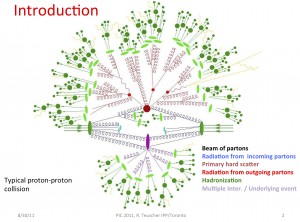
A fundamental ingredient in interpreting all new physics results at the high energies of the LHC is understanding how the proton looks when it collides with another proton at these energies. There were talks on QCD, jet production, and understanding the “underlying event” in proton-proton collisions. My favorite graphic (left) resulted from one of these talks: a cartoon of what the proton collisions “actually” look like when represented by Feynman-diagram-like images (from the talk by Richard Teuscher (University of Toronto)).
Searches at colliders for physics beyond the Standard Model
In short: nothing yet. If we had all been optimistic that new physics would rain from the LHC once it was turned on, reality has been a harsh truth. That isn’t to say that new physics isn’t there to be discovered. It is, however, fair to say that all the “low-hanging fruit” we expected to pick early and fast – the minimal Supersymmetric Standard Model (MSSM), or new heavy long-lived particles, or extra spatial dimensions, or quantum black holes – are not easy picking. It may be that new physics just won’t follow the conventions that have been expecting for the last 3 decades. Whatever the reason, the road ahead to discovering what lies beyond the Standard Model may prove a tricky one.
Searches for Dark Matter
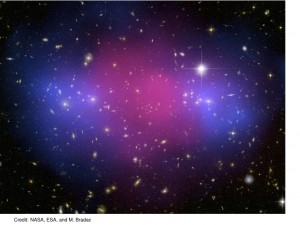
There were a few talks on the status of searches for dark matter. These covered astrophysical measurements (Hendrik Hildebrandt, University of British Columbia), collider searches for dark gauge bosons (Matt Graham, SLAC National Accelerator Laboratory), and direct searches for dark matter scattering off atomic nuclei (Emilija Pantic, UCLA). My favorite talk was definitely by Dr. Hildebrandt, who gave a sweeping and well-written overview of gravitational lensing and the astrophysical evidence for dark matter as a form of matter. He showed the bullet cluster and other galaxy cluster collisions, evidence that galaxies contain collisionless components (stars plus dark matter) that contain most of the mass and highly interacting components (the hot gas that emits x-rays) which are separated visibly by the collisions of the galaxy clusters.
Dr. Pantic spent a lot of time explaining how recent results from CoGENT and DAMA/LIBRA have been interpreted – often in what seems like a strained way – to mean there is a low-mass dark matter constituent. Many other experiments, often with similar or better sensitivity in the same interpretive framework, have seen no such thing. Clearly, a lot more work is needed to understand what is going on. My favorite bit of news was that a new experiment, DarkIce, will run at the South Pole and look for the same physical effect as has been observed by DAMA/LIBRA, albeit with an independent collaboration and detector.
Neutrino Physics
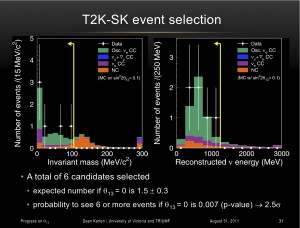
The one place where revelatory discoveries have been made in the last 20 years – neutrino physics – was very much on display at PIC2011. There were talks discussing the measured properties of neutrino interactions (Ronald Ransome, Rutgers University) as well as the status of current neutrino experiments. Of interest to many in the audience was the T2K Collaboration’s recent publication: Phys. Rev. Lett.107:041801,2011, “Indication of Electron Neutrino Appearance from an Accelerator-produced Off-axis Muon Neutrino Beam,” http://arxiv.org/abs/arXiv:1106.2822. T2K is reporting an inconsistency in their data with the null hypothesis for the neutrino mixing angle, θ13, which suggests that this mixing angle may be accessible to precision measurement by current beam and reactor-based neutrino experiments. I am VERY excited by this. It suggests, it it holds up under the strain of more data, that the reactor experiments will nail down this angle and the beam experiments can begin to probe CP violation in the lepton sector while further nailing down the angle.
